A lambrequin is an elegant decorative element designed to hide and decorate a cornice. Known since the 15th century, including thanks to historical photographs, it is widely used in the decoration of interiors in the Baroque and Empire styles, made from light or, on the contrary, dense, shiny fabrics and serves as a decoration for window or door openings in the hall, bedroom or children's room.
Types
Lambrequin (photo for the hall is given below in the article) in its original meaning was a richly decorated carved wooden structure responsible for the luxurious framing of the window. Subsequently, it began to be made of dense fabrics covering the cornice and decorated with various decor.

Today, there are several types of lambrequins known:
| Model type | Her characteristics |
| Classic lambrequins | They are a regular strip of tape. The distinctive feature of this type of lambrequin is the presence of decorative elements: swags, ties and jabots. The classic lambrequin has a wavy, straight or arched shape and covers the cornice or the upper part of the window. The products are also called "soft lambrequin" and vary depending on their type or shape. |
| Hard lambrequins | They are made of fabric and a rigid frame, which allows them to retain their shape for a long time. Special accessories are used to decorate them, decorating not only the window, but the entire visit. |
| Lambrequins with coquille, jabot, tie | Soft models are decorated with folds or decorative elements and are quite complex to make. |
| Combined lambrequins | They combine soft and hard elements, are quite difficult to manufacture and can be semicircular, straight and rectangular. |
| Bando | Decorative lambrequins made of rigid non-woven material and attached to the window with Velcro or glue. This model goes well with curtains, gives the room a romantic look and visually expands its space. |
| Openwork lambrequin | A variation of a women's lambrequin, presented not by a solid surface, but by a lace ornament made of dense material. This version of the lambrequin can become deformed due to excess moisture. |
| Modular lambrequin | It is a complex massive structure, composed of various, different-sized parts, with a complex pattern and ornament. |
| Plank lambrequin | A modern style of tape decor, produced in rolls and used to decorate children's rooms and bedrooms. |
| Asymmetrical lambrequin | A decorative ornament for windows and doorways, made of soft material with asymmetrical patterns or edges. This model is ideal for a classic interior. |
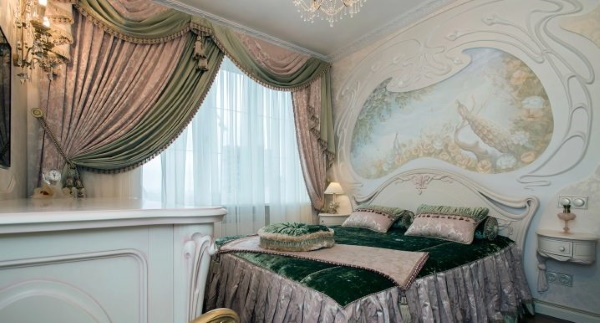
Lambrequins are made from both dense (jacquard, velvet) and light (chiffon, silk) fabrics. The main condition here should be the ideal combination of the future decor with the rest of the room.
Material
Heavy lambrequins, made in a classic style, according to decorators, add splendor and elegance to the room, are intended to decorate the living room and are made from:
- jacquard;
- flax;
- cotton;
- atlas;
- ivy;
- velvet.
Light and airy models add elegance to the chosen room and are sewn from:
- silks;
- taffeta;
- polyester;
- organza.
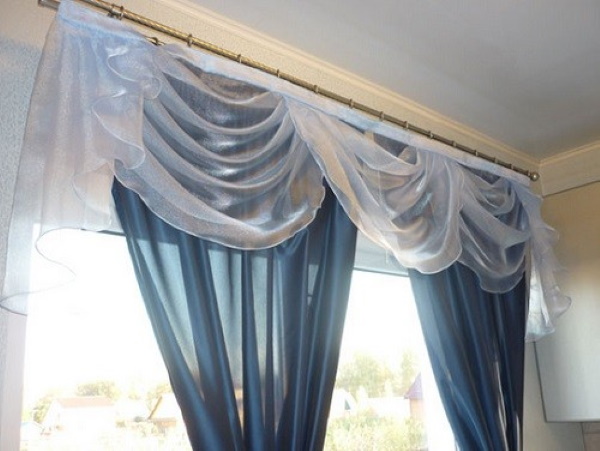
The material for making the lambrequin is selected based on the style of the chosen room.
Professional decorators advise:
- To decorate your living room, choose heavy, elegant materials such as velvet, satin and jacquard.
- Decorate the window openings in the bedroom with crepe satin, linen or organza.
- For the kitchen, use practical cotton, linen or polyester.
To sew a lambrequin yourself you will need:
| Necessary materials | How to choose |
| Drapery fabric | It is chosen depending on the taste of the hostess and should be in harmony with the main interior of the room. |
| Hard lambrequin | It is a strip made using laser cutting. This model is used to give the fabric base strength, and also complements and completes the composition. |
| Lining fabric | Non-woven or double linen |
| Additional elements | · millimeter paper; · measuring tape; · decorative cord; · pencil with a ruler; · tailor's pins; · sharp scissors |
Master classes
The lambrequin (the photo for the hall demonstrates various variations of fabric decoration for a window or door opening) should cover the cornice or be located on the curtains.
Classic (soft lambrequin)
The calculation of the fabric required for sewing is made depending on the size of the cornice and the selected material.
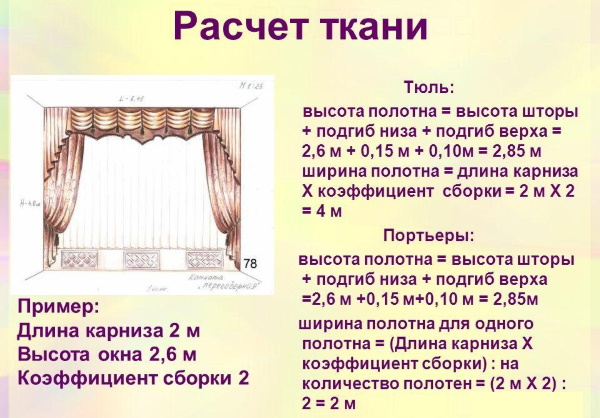
So, with a material length of 10 m and a cornice of 4 m, the calculation is:
10 – 4 = 6 – 0.05 m (required for hemming) = 5.95 m
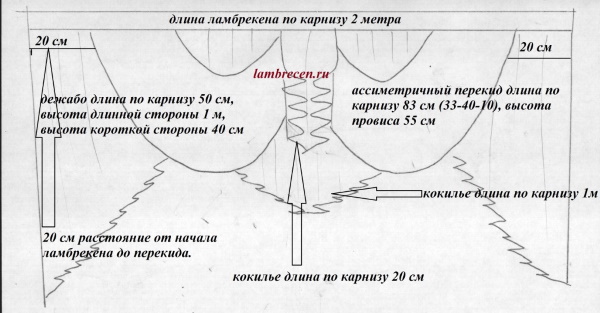
According to calculations, 5.95 m of fabric needs to be gathered into folds. Based on this figure, it is easy to find out the number of folds required: 5.95 / 0.1 = 59.5 pcs.
The production of a lambrequin depends on the type of decoration:
Soft lambrequin de Jabot
A soft lambrequin with a frill is made from:
- dense or light fabric;
- lining material;
- curtain tape;
- bias tape.
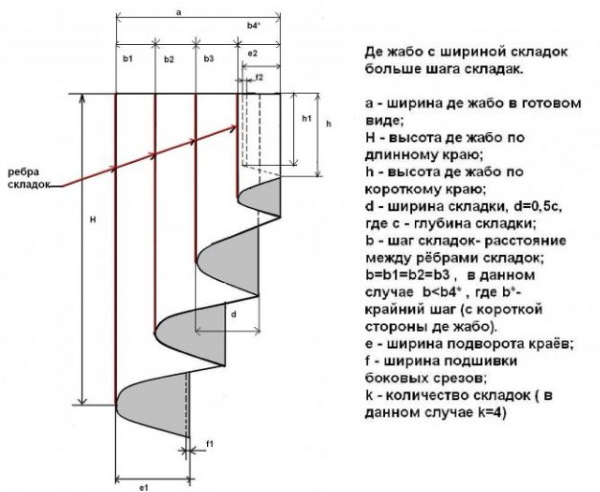
The width of the finished lambrequin should correspond to the cornice that holds it, and the length of the product is chosen at the discretion of the owners of the room (but not below floor level).
When calculating the lambrequin pattern, it is necessary to add 2-3 cm (seam allowance) to its desired height, and the fold gathering coefficient should be equal to 2.5–3. When calculating the size of the main fabric, the length of the cornice is multiplied by the length of the decorative elements. The size is determined separately for each of them.
The product model is first drawn on paper, then patterns are created and the fabric is cut out:
- A triangle is used to make a flounce de jabot, used to decorate a lambrequin. In some parts of the model, the decorated elements merge into the main fabric.
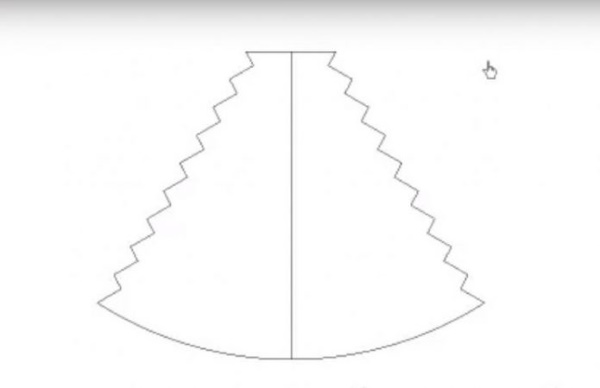
- In accordance with the drawn pattern, decorative elements are cut out from the main material. Their lower and upper edges are processed with piping.
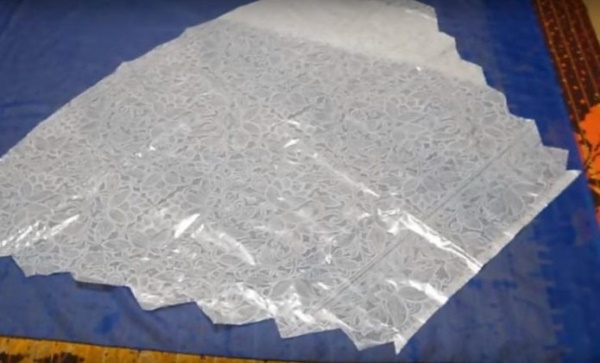
- To form a jabot, the fabric pattern should be laid out on the floor and draped in even folds. The future folds are fixed in the upper part of the product with tailor's pins.

- The formed folds need to be stitched along the top of the product. The second element of the jabot is made in a similar way.
- The prepared elements of the product should be secured to the curtains for ease of work, leaving a small sag of fabric between them. It should be secured to the previously prepared frills.

- The fully assembled model should be fixed at the edges and covered with a piece of fabric, and the excess fabric should be trimmed with scissors. The folds are sewn with a machine stitch, as well as the curtain tape attached to the edge of the product.
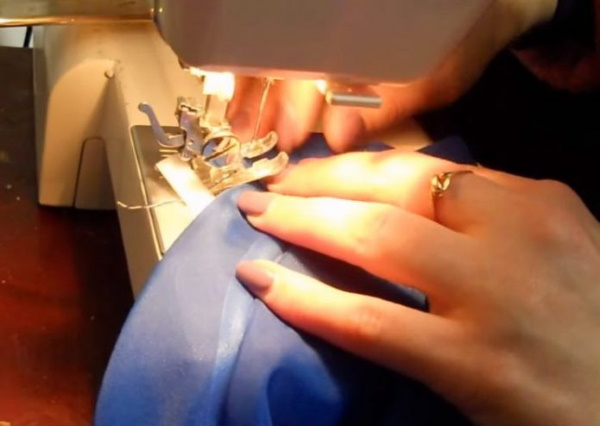
- To create even stitches, it is recommended to baste the product with contrasting threads.
Openwork lambrequin
The figured lambrequin is made from material and a rigid base using the guilloche method.
This handicraft technique involves finishing products with openwork lace and making appliqués by burning with a special device and, for its creation, requires the use of:
- dublerin;
- main fabric;
- patterns with the selected pattern;
- parchment paper;
- adhesive web;
- any burning tool;
- pins, scissors, iron.
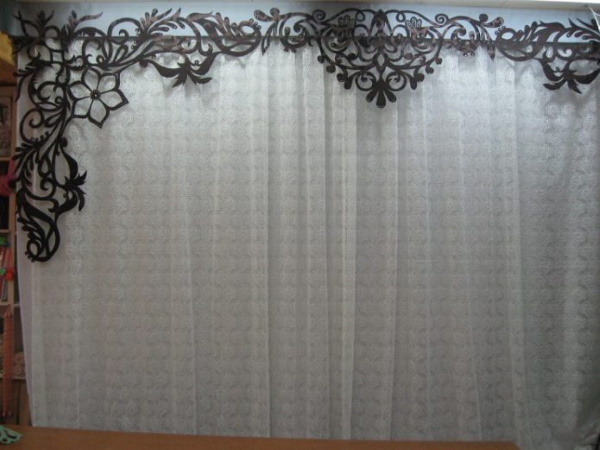
When making a model:
- It is necessary to make a pattern template, applying the selected pattern to it so that its size exactly matches the parameters of the finished product. Having applied the finished layout to the interlining, it is necessary to fix it with pins.
- To make an openwork pattern on a table (or other wide surface), place parchment paper, a template with a pattern, and adhesive web on top of each other.
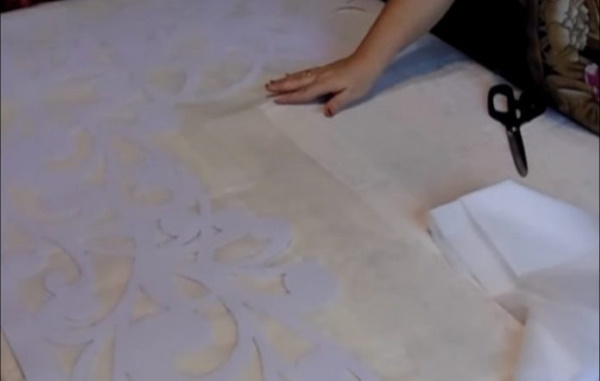
- You need to place the fabric on the top of the structure, and then, ironing it with a heated iron, melt the adhesive base, connecting the material with the rest of the product.
- The glass backing is placed under the lambrequin blank, and using a burning device, the pattern is carefully traced along the edge, separating it from the fabric base.

- The finished lambrequin is fixed to the cornice using adhesive tape.
Labrikenchik-bando
Photos of halls decorated with lambrequin-bando demonstrate its rigid part, complemented by a soft base, made with the help of:
- dublerin;
- adhesive interlining;
- curtain tape.
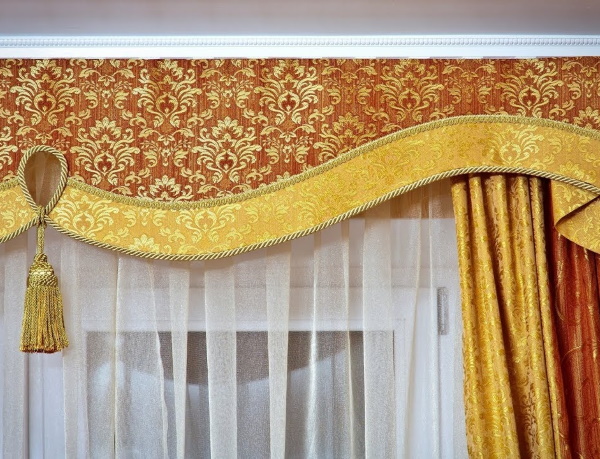
In progress:
- On paper you need to create the desired design of the product and cut it out.
- The main fabric must be fixed on the prepared base by ironing. The lining is glued to the workpiece from the back side.
- The excess fabric must be cut off, and the edge of the lambrequin must be finished with a zigzag stitch.
- A Velcro tape, which is necessary for fixing the lambrequin, must be sewn to the top of the model.
- The finished product is attached to the cornice with adhesive tape and decorated with a soft, fabric part.
Simple lambrequin
A lambrequin (photos for the hall offer various options for fabric decoration of window openings) sewn from a veil is ideal for decorating a kitchen or bedroom.
The following are used in its production:
- light, veil-like fabric (chiffon or organza);
- bias binding in a suitable color;
- curtain tape;
At the beginning of the work, a pattern of the product is made. To create it, the length of the cornice should be multiplied by the gathering coefficient, depending on the number and volume of folds. To the resulting value, you need to add 10 cm. Thin, easy-to-drape fabrics require a smaller coefficient, from 1.5 to 3.5. When using a standard curtain tape, the gathering coefficient will be 2. The extra 10 cm are needed to process the edges of the model.
When making a lambrequin:
- The main fabric is folded in half, which makes it easier to transfer the pattern onto it. When cutting, it is necessary to add 1 cm to the product parts (for seams).
- The perimeter of the resulting parts should be processed with bias tape.
- At the top edge of the lambrequin (from the inside), you need to sew on the curtain tape, and then, carefully pulling it, assemble the product.
- The product must be attached to the cornice using adhesive tape.
Hard lambrequin
Lambreichik (the photo for the hall shows options for combining various styles when making a model) of a rigid type is made from a material called thermo-bando, which allows you to achieve a beautiful and harmonious result without creating complex patterns.
When manufacturing a product:
- The lambrequin pattern needs to be transferred to the thermal bando, carefully cutting it out along the lines. There is no need to add seam allowances here.
- Exactly the same pattern needs to be transferred to the fabric and the product cut out, leaving an additional 1-2 cm (seam allowance).
- After folding the fabric and the thermal bando together, they need to be ironed (steam generator) to connect the material. This should be done carefully, constantly ensuring that the pattern applied to the base does not move and is glued evenly. In order to avoid distortion and the appearance of folds in the pattern, experts advise starting work from the center of the product, gradually moving to its edges.
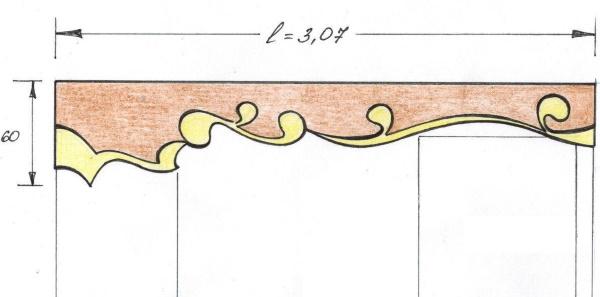
- The edges of the finished product should be finished with bias tape or braid.
- To the back side of the lambrequin, stepping back 2 cm from the top of the product, you need to carefully stick the adhesive tape, securing it so that it is not visible from the top edge.

Using adhesive tape, the lambrequin must be attached to the cornice.
Adviсe
The lambrequin (the photo for the hall offers to get acquainted with the options for making a decorative ornament hiding the cornice, complemented by a jabot, flounces or asymmetrical endings) is made depending on a number of factors.
Namely:
- Purpose of the room. For decorating living rooms, stylists advise choosing models made of heavy, bright fabrics, complemented by various decorative elements that decorate and emphasize the chosen interior of the room. Simple lambrequins made of translucent thin fabrics are suitable for decorating the kitchen. The same rule applies to decorating a children's room.
- The area of the room. According to stylists, voluminous models with a large number of decorations are only suitable for spacious rooms. In a small room, such a design will look very bulky and can visually reduce the room. Professionals also do not recommend decorating doorways with lambrequins in rooms with a small area.
- The ideal size for a lambrequin is considered to be 1/6 of the height from the cornice to the floor.
- Professional decorators advise choosing the color of the model in accordance with the tone of the curtains, which will allow you to create a harmonious and bright ensemble. According to designers, lambrequins made in a contrasting shade in relation to the curtains or sewn from chameleon fabrics look original, but such decoration will look harmonious only in a spacious room.
- The color of the fabric for the curtains and lambrequin is selected depending on the lighting of the room. Windows facing the sunny side should be darkened with a darker material.
Professionals do not advise beginners to take on the production of complex models of lambrequins. At the initial stage, they advise practicing on simple decorative elements, gradually moving on to more complex options. Lambrequin is a luxurious decoration of a window or doorway, made in a classic style and giving the interior a resemblance to photographs of halls decorated in the style of classicism, rococo or empire.
Made from soft fabric or having a hard base, such a model can become a bright decoration of a hall, bedroom or children's room, is made using simple patterns and does not require professional sewing skills.
Video on how to make lambrequins for the hall
How to make lambrequins:
